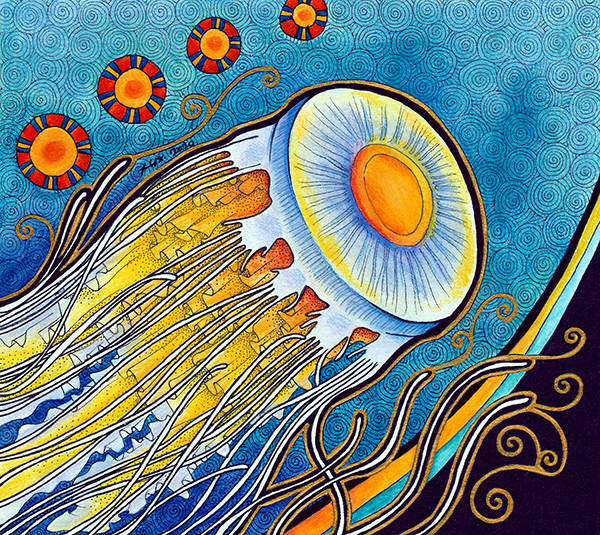Egg Yolk Jellyfish – Give a Little, Take a Little
Keywords:
Searching deep meanings. Thriving where others struggle. Conserve your energy. Drifting. At the mercy of life’s currents. Do what you can, learn to let go. Balance. Give a little, take a little. Unintentional generosity. Are you being taken advantage of? Ocean wisdom and magic. Deep sea wisdom. Trust, not gullibility.
Description:
The egg yolk jellyfish (Phacellophora camtschatica) is also known as the fried egg jellyfish. Its bell distinctly resembles a sunny side up fried egg. It is very large, with bells of around 60 centimetres (2 ft) in diameter, and tentacles that can trail for 6 metres (20 ft). They are sometimes confused with other species of jellyfish that look similar or have similar common names. Like many jellyfish, its range of motion is limited and influenced strongly by the currents, though it can actively swim. As with many jellyfish, they have no respiratory, circulatory or excretory systems. They lack a mesoderm and use mesoglea.
It is primarily a jellyfish hunter, collecting smaller medusae, as well as plankton. As a tentacle feeder, it will bring its food to its mouth to digest it. Its tentacles are covered with stinging sells (nematocysts) that help it capture its prey, and protect it to a degree from predators, though its stinging cells are weak compared to some of the more dangerous jellies.
Its life cycle contains many stages, but overall begins with a polyp that attaches to rocks and piers that reproduces asexually, followed by a medusa form (the more familiar jellyfish we’re used to seeing) that reproduces sexually.
The medusae prefer cool waters, such as those in the Northern Pacific, though they prefer to reproduce in warmer water. It has also been found in the Sea of Japan and the Sea of Okhotsk. It prefers to aggregate over deep basins. They have shown some population increase in areas with degraded ocean environments, and large numbers are indicators of poor ecosystems. Egg yolk jellyfish move faster during the day. They also engage in vertical migrations. To avoid competition, they will sometimes dive into hypoxic zones where less oxygen discourages other lifeforms. They are able to withstand these environments for hours.
It is not uncommon for the egg yolk jellyfish to be a host to symbiotic and parasitic lifeforms, such as crustaceans (larval crabs, amphipods) and young jack fish, who will even steal food off the egg yolk jelly’s arms. Generally, larval crabs are symbiotic, eating the parasitic amphipods to benefit the jellyfish, and gaining motion through the waters as well as exposure to warmer water at the surface which helps them grow faster. When the crab is older, it will begin to feed on the egg yolk jellyfish itself. Its main predators are crabs, deep-sea octopus and turtles. They live for approximately six months.
Was this helpful?
0 / 0